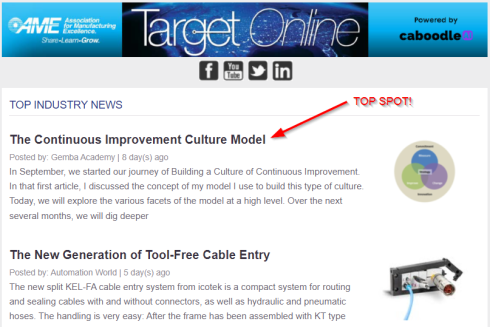
Gemba Academy
Continuous Improvement guest blogging at Gemba Academy
Top Spot on the Association for Manufacturing Excellence (AME) Target Online email!
NEW: A Company’s Continuous Improvement Journey
In the pursuit of excellence, many companies embark on a journey of continuous improvement, hoping to achieve lasting transformation. However, despite dedicated efforts, real fundamental change often remains elusive. The issue lies not in the efforts themselves but in the underlying approach.
Unlock Your Potential with Gemba Academy’s Master Black Belt Program
Are you ready to elevate your career and become a strategic leader in Lean and Six Sigma methodologies? Gemba Academy’s Master Black Belt (MBB) program is your pathway to mastering continuous improvement and driving significant business impact.
Aligning 5S and DMAIC for Process Improvement
Process improvement coaching candidates often struggle to find practical and effective process improvement ideas to use for their certification projects. I often recommend integrating two well-established methodologies: 5S and DMAIC. When you look at what each approach is doing, you, too, might see the alignment.
Enhancing Organizational Efficiency through Supplier Process Improvement
The essence of focusing on supplier process improvement lies in recognizing that an organization’s supply chain is an extension of its business. When suppliers perform better, it improves final product quality, cost efficiency, and delivery timelines for the purchasing organization. The ultimate goal is to create a seamless flow of value from the supplier to the end customer, minimizing waste and enhancing quality throughout the supply chain.
Understanding the Customer Experience is a Keystone in Process Improvement
One of the most profound revelations from focusing on the CX is uncovering previously invisible touchpoints. Processes that businesses might overlook or undervalue can have a significant impact on the customer’s perception and experience. An email, a system notification, or even the layout of a store can influence the customer journey in ways that are often underestimated.
Embracing System-Level Problem Solving over Firefighting
In the dynamic landscape of business and organizational management, problem-solving is often equated with ad hoc firefighting – a reactive approach where individuals scramble to douse the flames of immediate issues. While this method showcases individual heroism and quick thinking, it begs the question: “Is there a more effective way to address these challenges?”
Is Process Improvement Certification Right For Me?
Process improvement, at its core, is about enhancing the efficiency and effectiveness of various processes within an organization. It involves identifying, analyzing, and improving existing business processes to meet new goals and objectives, such as increasing profits, performance, and quality. The journey to becoming proficient in process improvement can be transformative, but it is essential to determine whether certification is a stepping stone you need or a diversion from your path.
Harnessing AI Large Language Models for Process Improvement
Artificial Intelligence (AI) is on everyone’s lips these days. In the realm of AI, Large Language Models (LLMs) are emerging as pivotal tools capable of understanding and generating human-like text. However, the capability extends far beyond mere text generation, offering businesses an opportunity to leverage them for process improvement. Have you considered how your businesses might utilize LLMs to enhance and streamline your processes?
In a world that is increasingly conscious of the environmental impact of industrial and corporate actions, the term “Green Process” has emerged as a beacon of hope and a pathway to sustainable development.
Implementing 5S in Your Company
In an era where business competition is fierce, having a streamlined operation can give you a significant edge. One effective strategy to achieve operational efficiency is the 5S methodology. But how do you know if your company needs 5S? And if it does, how do you go about implementing it?
The Power of Creativity in Process Improvement Projects
Creativity was a very popular topic at the American Society for Quality’s (ASQ) 2023 World Conference on Quality and Improvement. As I audited the various breakout programs, those dealing with creativity were standing room only. In this article, we explore the importance of creativity in process improvement projects and how it can revolutionize organizational success.
Maximizing Efficiency with Warehouse Control
Warehouse control refers to the processes, systems, and strategies implemented to manage inventory, optimize space utilization, and ensure smooth operations within a warehouse. It involves maintaining real-time visibility, accuracy, and accountability of inventory, as well as streamlining processes and minimizing errors. Warehouse control extends beyond physical aspects and includes software and technology-driven solutions to enhance efficiency. It ensures that what is supposed to be in the warehouse is in the warehouse and is in the location it is supposed to be in.
Spring cleaning is an excellent opportunity to declutter, reorganize, and eliminate anything that is no longer needed. When you combine it with the 5S system, you can create a more efficient and productive environment, whether at work or at home. So, let’s dive into the 5S’s.
Finding Process Improvement Opportunities
The common question I hear is, “How do I find a project?” In a very structured, process-minded environment, practitioners are handed projects.So much for the perfect world! In reality, most people need to find process improvement opportunities on their own. So, how do you do this?
Conducting Engaging Virtual Meetings
Understanding and measuring process time is one of the most important aspects of process improvement. Much of the waste (muda) in a process causes a process to take longer than it should. When a process takes longer, customers are waiting for their final products and services and people in the process are typically costing the company more money. After all, “Remember that time is money,” Benjamin Franklin. However, timing a process can sometimes also be a time-consuming process. And, if time is money, then quickly getting a good understanding of process cycle time, when conducting process improvement, is imperative.
What happens when the process is all online? Where everything that is happening, is on screens and is all 1s and 0s.This is when we need to go to the “electronic gemba!” There are two activities, typically done in succession: 1) A Wall Walk, and 2) A Functional Analysis.
Making Big Problems Into Little Problems
Process improvement says, “Figure out what is causing the fire and ensure that you put the fire out in such a way that it does not come back.”That’s Root Cause Analysis.
Root Cause to Solution Identification Simplified
Throughout Gemba Academy’s courses, there are several quantitative (inferential statistics, statistical process control, analysis of variances, etc.) methods to help identify the root cause. Also, there are several brainstorming-based approaches with formalized tools, such as 5 Whys and the Fishbone Diagram. However, there is a simpler way to get to the root cause and determine what to do about it.
How The Project Charter Evolves
A Project Charter is a contract that clearly explains what the process improvement project is all about, while also clearly stating when the team intends to accomplish the objectives of the project. The Project Charter should be carefully created and then shared in such a way that the team members and leaders from the organization understand what the project is all about.
The Four Types of Measures and Why Each is Important
Data is key to process management and improvement and The Continuous Improvement Culture Model relies on data measurement as a key component of creating this culture. Throughout Gemba Academy’s videos and certifications programs, the importance of data and measurement are discussed continuously.
Three Most Important Metrics in a Continuous Improvement Culture
How many things do you measure in order to tell you how you are doing in business? I have seen organizations that measure everything and anything. Many times, what is being measured is not something the business can do anything about. In some cases, the measures collected, reported, and reviewed, mean little to nothing to the operation and quality of the business.
Why Traditional Measurement Approaches Do Not Change A Culture
If you hope to create a culture of continuous improvement, then start measuring what you do if you are not measuring anything. However, what I often find, when things are being measured, is that what is being measured and how it is being measured do not drive any cultural change in behavior.
Engaging Partners and Suppliers on Your CI Journey
“Many hands, make light work.” The concept of a culture of continuous improvement is to orient everyone in the organization toward one common goal — Operational Excellence. You may have also heard of the psychology term, “The whole is greater than the sum of its parts.” In essence, this means that together many things can be something greater than themselves apart. You often hear about this in regards to teamwork and, as someone with 21 years of active service in the Air Force, I was repeatedly witness to teamwork in action.
Developing Leadership Through Tours
Leadership development is extremely important if you are trying to change or create a new culture in your organization. Many times, the leadership wants to see culture change, but they really are not sure what the new culture looks like or how to model the proposed change. This is just as true when you are talking about building a culture of continuous improvement.
Continuous Improvement Development for Leadership and Professionals
Leaders and managers drive culture through their actions – it takes both sides of the equation to be successful, thus it takes both leadership and management traits in your senior employees to enact this type of culture shift for your organization. The problem lies when the leaders and managers – the professionals in the organization – do not know “what” the change looks like or “how” to make the change. The first step in the strategy model was to Define the Foundation. A crucial step in your journey is to develop those that will lead this effort first. Thus, you must start with a foundation for your leadership.
The Continuous Improvement Culture Model
What framework can follow to build a culture of continuous improvement in your business? In my 32 years of process improvement experience, I've heard the phrase, "continuous improvement," thrown around with abandon. However, has anyone ever told you how to structure a continuous improvement program? Has anyone shared and described the framework that you should follow to make those two words a reality? I'm going to take a guess and say that the answer is, "No." "Just do process improvement all the time," is the typical guidance. "Just do it..." Well, this isn't Nike!
Building A Culture Of Continuous Improvement Part Two
The worst thing created by organizational growth is the deadly “Silo!” Call it what you like, silo, sandbox, camp, etc., these structures always tend to inhibit improvement in any organization. In 2019, I released my first business book, Overcoming Organizational Myopia: Breaking Through Siloed Organization. To fully understand how to breakthrough siloed organizations, read this book, but for now, let us simply talk about organizing for the purpose of continuous improvement.
Crafting Your Continuous Improvement Strategy
Creating a continuous improvement culture provides a strategic advantage for any company and should be implemented by following a specific strategy.
A Culture of Continuous Improvement Begins with Leadership
Leaders set the environment for this culture of continuous improvement. Everyone always wants to blame the failure to set a culture, or a bad culture, on leadership. Leaders are responsible for setting the culture, but it takes more than leadership. I do not believe it is fair to blame all of cultural woes on leadership. In fact, I think that leaders shoulder way too much blame for a poor culture.
How to Build a Culture of Continuous Improvement
Building a culture of continuous improvement is not easy and can take a considerable amount of time. However, it is very possible, and results will be felt within months, if not weeks, of seriously embarking on a journey to continuous improvement.
To schedule an appointment or find out more about the services we offer:
Call 210 504-6175
Or use our contact form.

